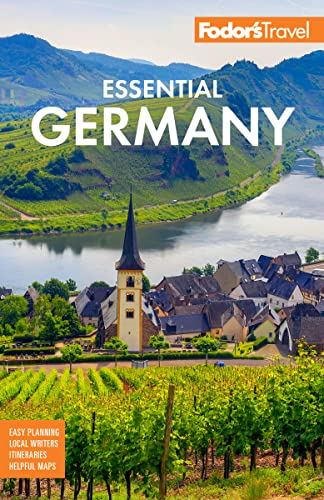About German Beers
Beer, or "liquid bread" as it was described by medieval monks who wanted to avoid God's anger, is not just a vital element of German cuisine, but of German culture. The stats say Germans are second only to the Czechs when it comes to per capita beer consumption, though they have been losing their thirst recently—from a peak of 146 liters (about 39 gallons) per head in 1980, each German now only manages 107 liters (roughly 28 gallons) every year. And yet the range of beers has never been wider.
Reinheitsgebot (Purity Law)
There are over 1,300 breweries in Germany, offering more than 5,000 types of beer. Thanks to Germany's ancient "Beer Purity Law," or Reinheitsgebot, which allowed only three ingredients (water, malt, and hops), they are all very high quality. The water used in German beer also has to meet certain standards—a recent discussion about introducing fracking in certain parts of Germany was roundly criticized by the German Beer Association because the water in the area would become too dirty to use for making beer.
Germany’s Major Beer Varieties
Pils: One effect of the Beer Purity Law was that Germany became dominated by one kind of beer: Pils. Invented in Bohemia (now the Czech Republic) in 1842, and aided by Bavarian refrigeration techniques, Pils was the first beer to be chilled and stored, thus allowing bottom fermentation, better clarity, and a longer shelf life. Today, the majority of German beers are brewed in the Pils, or Pilsner, style. German Pils tends to have a drier, more bitter taste than what you might be used to, but a trip to Germany is hardly complete without the grand tour along these lines: Augustiner in Bavaria, Bitburger in the Rhineland, Flensburger in the north.
Helles: Hell is German for "light," but when it comes to beer, that refers to the color rather than the alcohol content. Helles is a crisp and clear Bavarian pale lager with between 4.5% and 6% alcohol. It was developed in the mid-19th century by a German brewer named Gabriel Sedlmayr, who adopted and adapted some British techniques to create the new beer for his famous Spaten Brewery in Bavaria. Another brewer, Josef Groll, used the same methods to produce one of the first German Pils, Pilsner Urquell. Spaten is still one the best brands for a good Helles, as are Löwenbräu, Weihenstephaner, and Hacker-Pschorr—all classic Bavarian beers.
Dunkelbier: At the other end of the beer rainbow from Helles is dark beer, or Dunkelbier. The dark, reddish color is a consequence of the darker malt that is used in the brewing. Despite suspicions aroused by the stronger, maltier taste, Dunkelbier actually contains no more alcohol than Helles. Dunkelbier was common in rural Bavaria in the early 19th century. All the major Bavarian breweries produce a Dunkelbier to complement their Helles.
Bock: Dunkelbier should not be confused with Bock, which also has a dark color and a malty taste but is a little stronger. It was first created in the Middle Ages in the northern German town of Einbeck, before it was later adopted by the Bavarian breweries, which had come to regard themselves as the natural home of German beer. In fact, the name Bock comes from the Bavarian interpretation of the word "Einbeck." Bock often has a sweeter flavor, and is traditionally drunk on public holidays. There are also subcategories, like Eisbock and Doppelbock, which have been refined to make an even stronger beverage.
Kölsch: If you're looking for lighter refreshment, then Kölsch is ideal. The traditional beer of Cologne, Kölsch is a mild, carbonated beer that goes down easily. It is usually served in a small, straight glass, called a Stange, which is much easier to wrangle than the immense Bavarian Mass (liter) glasses. If you're part of a big party, you're likely to get Kölsch served in a Kranz, or wreath—a circular wooden rack that holds up to 18 Stangen. Kölsch is very specific to Cologne and its immediate environs, so there's little point in asking for it anywhere else. Consequently, the major Kölsch brands are all relatively small; they include Reissdorf, Gaffel, and Früh.
Hefeweizen: Also known as Weissbier or Weizenbier, Hefeweizen is essentially wheat beer, and it was originally brewed in southern Bavaria. It has a very distinctive taste and cloudy color. It's much stronger than standard Pils or Helles, with an alcohol content of more than 8%. On the other hand, that content is slightly compensated for by the fact that wheat beer can be very filling. For a twist, try the clear variety called Kristallweizen, which tastes crisper, and is often served with half a slice of lemon. Hefeweizen is available throughout Germany, and the major Bavarian breweries all brew it as part of their range.
Top Brews by Region
Bavaria: Helles, Dunkelbier, Hefeweizen.
The six most famous brands are also the only ones allowed to be sold at Oktoberfest: Löwenbräu, Augustiner, Paulaner, Hacker-Pschorr, Spaten-Franziskanerbräu, and Hofbräu. Tegernseer Hell is also very good.
Rhineland: Kölsch, Pils.
Apart from Kölsch, which is impossible to avoid, look out for Krombacher and Bitburger.
Eastern Germany: Pils.
Radeberger and Hasseröder are two of the few beers in the region to have survived the fall of communism in former East Germany.
Berlin: Pils.
The most famous brands are Berliner Kindl, Schultheiss, and Berliner Pilsner, which are all worth trying.
Hamburg: Pils.
Astra—with its anchor-heart logo—is a cult Pils that is very much identified with Germany's biggest port city.
Northern Germany: Pils, Bock.
The best brands include Flensburger, Jever, and, of course, Beck's, which comes from the northern city of Bremen.




